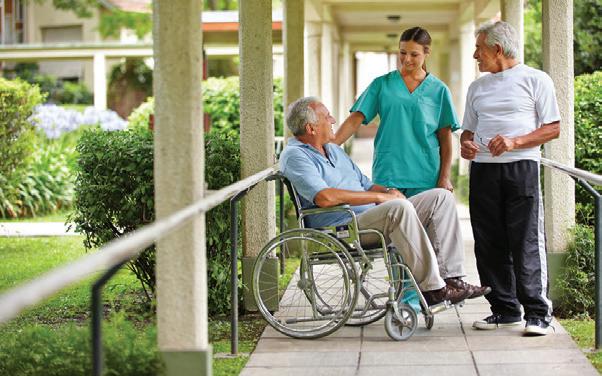
4 minute read
Variables that elevate the risk for MS
Multiple sclerosis cases are on the rise. According to the MS International Federation, the estimated number of people with MS globally increased from 2.3 million in 2013 to 2.8 million in 2020.
It is useful for people to learn the various risk factors for MS, which affects the brain and spinal cord and causes various symptoms, including vision loss, fatigue and impaired coordination. Though the National Multiple Sclerosis Society (NMSS) notes that the cause of MS is not known, the organiza - tion reports that several factors are believed to contribute to the overall risk.
Advertisement
• Geographic gradient: Epidemiologists, who study disease patterns in large groups of people, know that MS occurs more frequently in areas that are farther from the equator. Though the reason behind that remains a mystery, studies have shown that people born in areas considered high risk for MS who move or migrate to areas with lower risks for the disease before the age of 15 assume the risk of their new area. The NMSS says this suggests that exposure to some environmental agent prior to puberty may predispose a person to develop MS later in life.
• Vitamin D: The NMSS reports that low vitamin D levels in the blood have been identified as a risk factor for MS. In fact, because the sun is a natural source of vitamin D, some researchers feel that exposure to sunlight could explain the geographic component of MS risk. Individuals who live closer to the equator are exposed to greater amounts of sunlight year-round than others, which increases their levels of naturally-produced vitamin D.

• Smoking: Studies have indicated that smoking is another factor related to an increased risk for MS. The NMSS also indicates that smoking is associated with more severe disease and a more rapid progression of it. Recognition of this link is significant, but it’s equally important that current smokers know that stopping smoking – either before or after the onset of MS –is linked to a slower progression of disability.

• Obesity: The NMSS reports that obesity in childhood and adolescence, particularly in girls, also increases the risk of MS later in life. Young adults should know that a similar link has been found between MS and obesity in early adulthood. MS diagnoses are on the rise. Recognition of the variables that can contribute to such a diagnosis can help people better understand their risk.
What to know about cardiac arrest
On a Monday night in early January 2023, the Buffalo Bills were in Cincinnati to take on the hometown Bengals. The game was a highly anticipated, primetime matchup between two of the best teams in the National Football League, but it would be interrupted and ultimately postponed after Bills safety Damar Hamlin suffered a frightening injury during the game. After tackling Bengals wide receiver Tee Higgins, Hamlin stood up, only to fall flat moments later. Medical personnel rushed to Hamlin’s side, and it was later determined he went into cardiac arrest.
Days went by as football fans across the nation prayed for Hamlin’s recovery. Good news arrived by the end of the week, as doctors treating Hamlin reported his condition showed marked improvement. Indeed, within days of that news, Hamlin was on his way back to Buffalo, much to the delight of millions of people across the country.
GHamlin’s story made international headlines and left many people across the globe asking questions about cardiac arrest. What is cardiac arrest?
Cardiac arrest occurs when the heart suddenly and unexpectedly stops pumping, meaning that blood stops pumping to the brain and other vital organs. Immediately after Hamlin’s collapse, emergency workers began administering CPR and other resuscitation efforts. This rapid response helped preserve the 24-year-old safety’s neurological function.
How dangerous is cardiac arrest?
The NHLBI notes that cardiac arrest is a medical emergency. In fact, the NHLBI indicates that nine out of 10 people who have cardiac arrest outside of a hospital die.
(See Cardiac, next page)
Wellness

Local choices in health, healing & fitness.




(See Cardiac, previous page)
What are the symptoms of cardiac arrest?
Johns Hopkins Medicine notes that there are no prior symptoms in some cases of cardiac arrest. However, individuals may experience these symptoms prior to cardiac arrest:
• Fatigue
• Dizziness
• Shortness of breath
• Nausea
• Chest pain
• Heart palpitations
• Loss of consciousness
What causes cardiac arrest?

The suddenness of the injury to Hamlin undoubtedly left millions of people confused about how the condition could affect a young professional athlete seemingly in peak physical condition. Some medical experts have suggested Hamlin’s episode was an instance of commotio cordis when the heart is hit by a blunt force at a specific time in the heart’s normal rhythm. This can cause the heart to go into arrhythmia or stop beating. In general, Johns Hopkins reports that there are usually three main causes of the condition.
• Arrhythmia and ventricular fibrillation: Arrhythmia is a condition marked by problematic electrical signals in the heart that lead to an abnormal heartbeat. Ventricular fibrillation is a type of
Membership Specials



arrhythmia that causes the heart to tremble rather than pump blood normally. It is the most common cause of cardiac arrest.
• Cardiomyopathy: Cardiomyopathy is a condition in which the heart is enlarged. Johns
Hopkins notes that when a person has cardiomyopathy, the heart muscle thickens or dilates, which causes abnormal contractions of the heart.
• Coronary artery disease: The NHLBI indicates that most people who experience cardiac arrest have heart disease, even if they didn’t know it beforehand.
The most common type of heart disease is coronary artery disease, which is marked by the buildup of cholesterol inside the lining of the coronary arteries.
That buildup leads to the formation of plaque which can partially or completely block blood flow in the arteries of the heart. Certain behaviors or lifestyle choices also can trigger cardiac arrest. For example, the NHLBI reports that heavy alcohol consumption or recent use of cocaine, amphetamines or marijuana can cause cardiac arrest. Severe emotional stress and physical exertion, including that which is typically required of competitive athletes, also can trigger cardiac arrest.
The Damar Hamlin incident thankfully appears to have had a happy ending. But millions more people could be vulnerable to cardiac arrest. More information is available at nhlbi.nih.gov.










